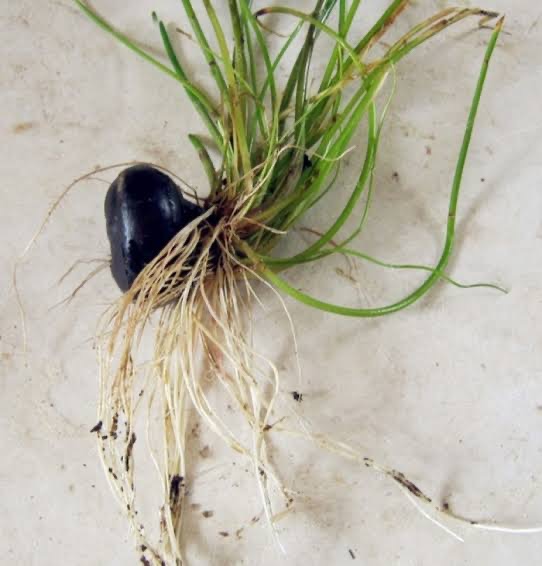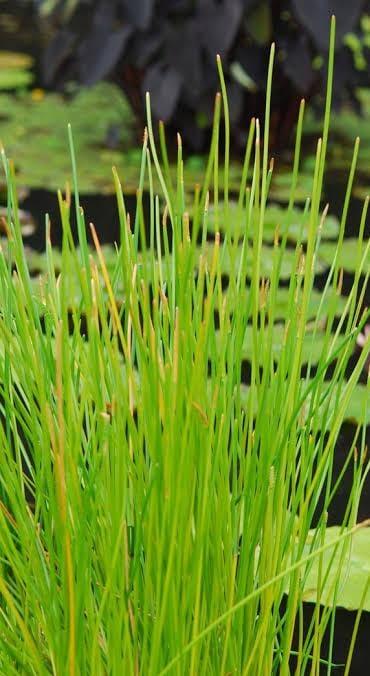Chinese Water Chestnut Plant
Chinese water chestnut, a perennial, prefers well-drained sandy-loam soil and full sun. It's frost-sensitive and benefits from regular watering.
Habit
Perennial
Height
1-2 m
Growth
Fast
Soil
Clay-rich, water-logged soil
Shade
Full Sun
Moisture
Moist
Edible
Yes
Medicinal
Yes
Origin
China, SE Asia
Climatic Condition
Tropical, Wetland
Temperature (°)
20-35°C
Humidity (%)
80-100%
Potting media
Water-grown
Fertilizers
Organic compost, potassium
Watering
Fully submerged
Plant Weight
50-200 g per corm
Flowering Time
Year-round
Soil Ph level
6.0 - 7.5
Water Ph level
6.0 - 7.5
Soil EC
1-2 dS/m
Yield Per Plant
2.3 kg of fresh matter per season
NPK ratio
10:10:10
life Span
Perennial
Health Benefits
Rich in fiber, antioxidants, low-calorie food
Suggested Grow Media or Potting Mix ?
50% loamy soil, 30% compost, 20% sand
Suggested Fertigation/Fertilizers
Fertilize every 6 weeks with a balanced, slow-release fertilizer.
Common Diseases and Remedies
foot rot, stem spot, downy mildew, yellow orange leaf virus and stem blight.
The diseased area turns brown or black and rot, Terminal leaves turn yellow droop off, The entire plant topples over and dies.
Trichoderma spp,neem oil
HEALTH BENEFITS
· Low in calories but rich in fiber, promoting digestive health.
· Good source of antioxidants and minerals like potassium.
· Helps regulate blood sugar levels and supports heart health
What Is An Chinese water chest nut Tree?
Water chestnut refers to water tuber producing plants of the genus Trapa. There are many different species, but Trapa natans is the best known. These aquatic plants are primarily found in freshwater environments such as ponds, swamps, and slow-flowing rivers. Known for their unique spiny fruit, water chestnuts are not nuts, but underground tubers that develop beneath the surface of water. The tubers are crunchy, white, and have a slightly sweet taste, making them a popular ingredient in a variety of Asian dishes. Water chestnuts are often used in stir-fries, salads, and desserts, adding crunch and a hint of sweetness to dishes. In addition to their culinary uses, plants in the water chestnut family contribute to aquatic ecosystems by providing habitat and supporting biodiversity.
What Are The Different Types Of Chinese Water chest nut Plants?
1. Water chestnut (Eleocharis tuberosa)
A type of water chestnut native to Japan. Known as "Korogashi", it is often used in Japanese cuisine.
2. Ludwigia adscendens
A type of water chestnut native to Thailand. In Thai, it is called "Munsamet" and is often used in Thai cuisine.
3. Waterfoot (Trapa natans var. bispinosa)
This is a type of freshwater aquatic plant that bears chestnut-like fruit. It is commonly known as the "ring nut" or "bat nut" and is found in many parts of the world, including China, India, Africa, and Europe.
4. African water chestnut (Eleocharis dulcis var. papillosa)
A type of water chestnut native to Africa. Also known as "kachongoro", it is grown for food in many African countries.
5. Vietnamese water chestnut (Eleocharis sphacelata)
A type of water chestnut native to Vietnam. It is commonly used in Vietnamese cuisine and is known as "hoi cua" or "mao cua".
How to care for Chinese water chestnut Plants ?
1. Location
Plants of the water chestnut family (Tlapa and Eleocharis species) are usually grown outdoors, especially in aquatic environments such as ponds, swamps, and slow-flowing rivers. They are adapted to life in water and require certain conditions such as sunlight, warmth, and access to shallow water for optimal growth.
2. Sunlight
Provide plenty of sunlight for at least 6 to 8 hours a day. Water chestnuts need plenty of sun to grow and produce good fruit. It requires at least 6 hours of direct sunlight per day for optimal growth and yield. If possible, water chestnut plants should receive 8 hours of direct sunlight each day. Water chestnut plants may not grow well and have difficulty producing healthy tubers if they do not receive enough sunlight. It is recommended to plant water chestnuts in a location that receives plenty of sunlight. B. In a pond without overhanging trees or in an environment with bright artificial plants. In regions with extreme heat, plants may need to be protected from strong sunlight to prevent overheating and drying out. In general, a sunny location is ideal for the water chestnut plant, as uniform sunlight is essential for its healthy growth.
3. Soil
Water chestnuts have unique soil requirements because they are aquatic plants that grow in partially submerged environments. Water chestnuts prefer sandy clay loam soils with a neutral pH of around 6.5 to 7.5. The best soil for growing water chestnuts is one that has a high organic matter content, is well-drained, and has the ability to retain water.
4. Hydration
Maintain a constant water level to keep the soil constantly moist. Avoid flooding as too much water can cause rot. Water chestnuts require a lot of water to grow properly, so they thrive in humid environments. It should be grown where it needs to be partially or completely submerged in water. When growing water chestnuts, keep the soil or substrate moist at all times to promote plant growth. Water chestnuts absorb water through roots that are anchored in the mud at the bottom of ponds and other bodies of water.
5. Nutrition
Balanced fertilizers with an NPK ratio of 10-10-10 or 14-14-14 are usually used in water chestnut cultivation. This provides a blend of essential nutrients that support overall plant growth. During the growing season, water chestnuts require large amounts of nitrogen to grow healthy leaves and stems. Root system development also requires an adequate supply of phosphorus and potassium.
6.Issues
Although water chestnut plants are valuable as edible tubers, they can pose certain challenges and problems. A major concern is its potential invasiveness, especially in species such as Trapa natans. In areas where water chestnuts do not grow naturally, water chestnuts can form dense floating mats that crowd out native vegetation, disrupting ecosystems and reducing biodiversity. Aggressive growth of water chestnut requires consistent management to prevent uncontrolled spread. Additionally, these plants may be susceptible to pests and diseases such as aphids and fungal infections, which can affect overall plant health and tuber development. Proper monitoring, early intervention, and strategic cultivation practices are essential to alleviate these problems and ensure sustained and controlled growth of water chestnut plants.
Water chestnuts have a number of benefits that make them a valuable addition from both a culinary and environmental point of view. Cultivated for its crunchy, sweet tubers, water chestnuts are a versatile ingredient in Asian cuisine. Adds crunchy texture to dishes such as stir-fries, salads, and desserts. Beyond its culinary appeal, water chestnut plants play an important role in aquatic ecosystems. They provide habitat and food for a variety of aquatic organisms and contribute to biodiversity. The dense growth of floating leaves also provides shade, regulating water temperature and reducing unwanted algae growth. In addition, water chestnut can improve water quality as it acts as a nutrient absorber. When managed sustainably, water chestnut cultivation and consumption can balance both culinary pleasure and environmental well-being.
FAQs About Growing Chinese Water Chestnut
1. What is water chestnut?
Water chestnut refers to an aquatic plant known for its edible tubers. The two main species are Trapa natans and Eleocharis dulcis, the latter often used in cooking.
2. How is water chestnut used in cooking?
Water chestnut is popular in Asian cuisine, especially in dishes such as stir-fries, salads, and desserts. Its crunchy texture and mellow sweetness add a unique accent to a variety of recipes.
3. Where do water chestnuts grow?
Water chestnuts usually grow in bodies of water such as ponds, swamps, and slow-flowing rivers. They thrive in warm tropical to subtropical climates.
4. Is water chestnut invasive?
Yes, some species of water chestnut, particularly Trapa natans, can be invasive. They form dense floating mats that can crowd out native vegetation in non-native areas.
5. How deep should water be when growing water chestnuts?
Water chestnuts generally grow in shallow water, about 6 inches to 2 feet deep.

